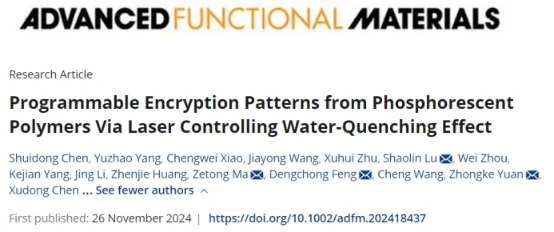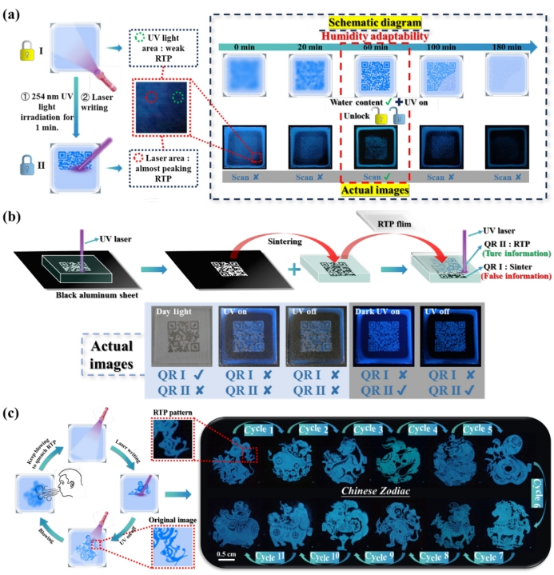Author: Source: Release Date: December 4, 2024 Views: 409 times
Recently, Professor Chen Xudong's team, including Lu Shaolin and others, combined the water-quenching phosphorescence effect of polyacrylamide-based room-temperature phosphorescence and the laser photothermal effect to achieve a non-contact rapid preparation technology for traceless phosphorescent patterns. The research results, titled "Programmable encryption patterns from phosphorescent polymers via laser controlling water-quenching effect," were published on November 26, 2024, in "ADVANCED FUNCTIONAL MATERIALS." The first author of the paper is Chen Shuidong, a master's student at the Guangdong University of Technology School of Light Industry and Chemical Engineering, with Guangdong University of Technology as the first completing unit, and the research work received technical support from the Rongjiang Laboratory of the Guangdong Provincial Laboratory of Chemistry and Fine Chemicals.

Research results introduction as follows:
Polymer-based organic room-temperature phosphorescence (RTP) has important prospects in information encryption and anti-counterfeiting applications. However, traditional patterning techniques such as screen printing and inkjet printing have issues like complex plate preparation, difficult ink formulation, and easy overload in batch printing, which limit RTP encryption and anti-counterfeiting applications. Inspired by the enhancement of RTP through the removal of localized water from polyacrylamide via ultraviolet photothermal effects, this study prepared a series of phosphorescent polymers for ultraviolet laser applications, obtaining two RTP materials with excellent performance: one with a phosphorescence lifetime of 2.34 s (phosphorescence efficiency 13.59%) and another with a phosphorescence lifetime of 1.46 s (phosphorescence efficiency 20.33%). The laser technology used has a built-in program that can accurately transfer patterns to phosphorescent film materials; this marking technology is programmable and non-contact, based on which advanced anti-counterfeiting functions such as phosphorescent humidity-adaptive time response, misleading conversion of true and false patterns, anti-fluorescence interference phosphorescent labels, and repeatable writing/erasing of exquisite patterns have been achieved. This work constructs an RTP polymer system with good processing performance, which has prospects for industrial applications and provides new ideas for RTP polymer-based functional materials in the practical application fields of optical encryption and anti-counterfeiting.

Figure 1. a) Phosphorescent humidity-adaptive time response; b) Misleading conversion of true and false patterns; c) Schematic diagram of the cycle for laser writing and artificial exhalation erasing of patterns (left).
Original link: https://doi.org/10.1002/adfm.202418437
 current position:
Home
>
News & Notices
>
News
>
Content
current position:
Home
>
News & Notices
>
News
>
Content